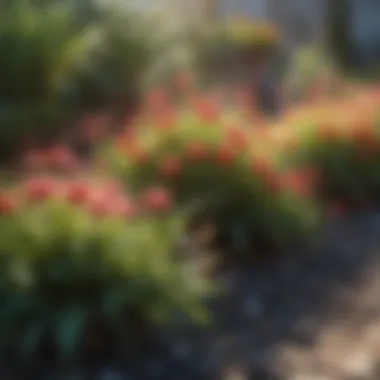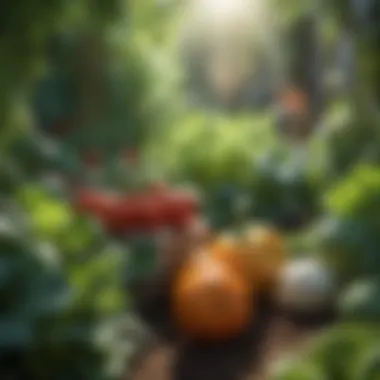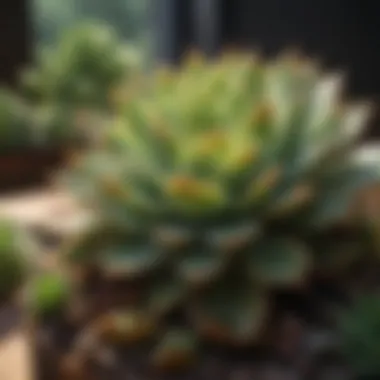Top Plants That Flourish in Full Sunlight


Intro
In the realm of gardening, few decisions are as pivotal as selecting the right plants for specific lighting conditions. Especially in sunlit gardens, the quest to find species that not only endure but thrive under harsh sunlight can be both exhilarating and challenging. Plants that flourish in direct sunlight often exhibit unique adaptations that allow them to utilize the sun's energy effectively, producing vibrant colors and robust growth.
Embracing a full-sun environment invites a rich variety of choices, spanning from ornamental flowering plants to hardy, drought-resistant succulents. This article aims to provide homeowners and gardening enthusiasts with a comprehensive guide on the best plant species suited for sun-drenched spaces. By exploring characteristics, care requirements, and aesthetic contributions, gardeners can cultivate verdant landscapes while ensuring that each plant reaches its potential.
Ultimately, understanding the nuances of each species will empower gardeners to create thriving outdoor spaces that bask in sunlight, enhancing both beauty and biodiversity in their gardens.
Understanding Full Sun Conditions
Understanding the conditions defined as full sun is crucial for gardeners aiming to cultivate plants that flourish in bright environments. This section provides an overview of what constitutes full sun, the implications it has on plant growth, and the geographic factors that influence sunlight exposure. Being well-versed in these aspects not only informs selection of plants but also aids in their long-term health and vigor.
Definition of Full Sun
Full sun typically refers to areas that receive at least six hours of direct sunlight each day. This designation is often used in horticulture to guide gardeners in choosing appropriate plants for their spaces. In many regions, full sun exposure is essential, especially during the warmer seasons when sunlight is more intense. Understanding this definition allows gardeners to effectively position their plants according to their light needs.
Implications for Plant Growth
The amount of sunlight plants receive dramatically affects their growth habits and overall health. Plants that thrive in full sun generally have adapted to higher light levels. They often exhibit characteristics such as:
- Sturdy growth patterns: This is essential for withstanding heat and potential drought.
- Enhanced blooming: Many flowering species require full sun to produce abundant flowers.
- Higher yield: Vegetables like tomatoes and peppers show significant increases in production in full sun settings.
However, it is important to note that not all plants are equipped to handle such conditions. Choosing species that are well-suited for sunlight ensures that they will grow properly and provide the desired aesthetics or yields.
Geographic Considerations
Geographic factors play a significant role in determining sunlight availability. In regions closer to the equator, sunlight is more intense and frequent throughout the year. Conversely, areas at higher latitudes often experience shorter days during winter and can find themselves limited by shadows from buildings or trees. Moreover, some microclimates can create variations in light intensity even within a relatively small area. This makes it essential for gardeners to observe their specific environment and adjust their plant selections accordingly.
In summary, understanding full sun conditions encompasses comprehension of definitions, implications for plant health, and geographic influences, thus forming a foundation for successful gardening.
Flowering Plants for Full Sun
Perennials That Flourish
Daylilies
Daylilies are renowned for their adaptability and robustness in sunny environments. They are favored for their vibrant blooms that come in a multitude of colors. The key characteristic of daylilies is their every-blooming nature, producing flowers from early summer to late fall. This continuous flowering period makes them a great choice for adding color to shades where other plants may struggle.
Their unique feature is the ability to thrive in various soil types, making them quite versatile. However, they do require regular watering in their initial growth phase to establish strong roots.
Black-eyed Susans
Black-eyed Susans stand out for their distinctive yellow petals with dark centers. They are a valuable addition to any garden due to their resilience in direct sunlight and drought conditions. The most appealing aspect of black-eyed Susans is their role in attracting pollinators, contributing to a healthy garden ecosystem. These plants typically bloom from summer to fall, and they can complement other flowering plants beautifully. One of their unique features is the ability to self-seed, which allows them to thrive in a garden year after year. However, they may require occasional deadheading to promote further blooms.
Sedum
Sedum is a succulent perennial that is known for its fleshy leaves and clusters of star-shaped flowers. Its ability to retain water makes it an excellent choice for gardeners in hot, dry climates. The key characteristic of sedum is its low maintenance needs and tolerance for poor soil conditions. Its unique feature lies in its diverse range of varieties, which can provide different colors and textures to the garden. One advantage of sedum is its prevention of soil erosion, making it an effective ground cover option. However, prolonged wet conditions can be detrimental to its health, requiring careful management of watering practices.
Annuals for Vibrant Color
Zinnias
Zinnias offer a burst of color and are easy to grow in sunny locations. They are highly regarded for their bright and diverse color palette. The key characteristic of zinnias is their ability to bloom continuously throughout the summer, bringing vibrancy to any garden. Their unique feature is the adaptability to various soil types, which makes them suitable for different gardening scenarios. They do require regular deadheading to maintain their blooming cycle, but their resilience and beauty make them worthwhile.
Petunias
Petunias are beloved for their vibrant flowers and pleasant fragrance. Their contributions are significant, especially in enhancing the visual appeal of garden beds. The key characteristic of petunias is their long blooming season, which can last from spring until the first frost.
One unique feature is their tolerance for heat, making them ideal for full sun exposure. However, petunias require consistent watering, especially in extreme heat, which poses a small challenge for some gardeners.
Marigolds


Marigolds add cheerful colors and are effective in pest control. They are noted for their ability to deter insects, making them beneficial companion plants in gardens. The key characteristic of marigolds is their resilience, thriving in full sunlight with minimal care. Their vibrant blooms can attract pollinators, which supports the overall health of the garden. A unique feature of marigolds is their relatively fast growth rate, allowing for quicker results in garden displays. However, they can attract certain pests, necessitating a balance in the garden ecosystem.
Vegetables Best Suited for Full Sun
Understanding which vegetables can thrive in direct sunlight is crucial for gardeners aiming to cultivate a robust and productive garden. Full sun conditions provide an ideal environment for many vegetables, increasing both growth rates and yields. Sun-loving vegetables typically exhibit a greater resistance to pests and diseases when planted in the right conditions. Furthermore, vegetables grown in full sun often develop richer flavors due to increased photosynthesis. Choosing the right varieties ensures not only a successful harvest but also a vibrant garden.
High-Heat Tolerant Varieties
Tomatoes
Tomatoes are a staple in many gardens, highly valued for their versatility and taste. They thrive in full sun, making them an excellent choice for direct sunlight areas. The key characteristic of tomatoes is their ability to produce fruit abundantly when exposed to ample sunlight and warmth. This makes them particularly beneficial for gardeners looking for a rewarding crop. However, tomatoes do require consistent watering, especially in extreme heat, to prevent stress. Despite this, their unique flavor profile and culinary uses outweigh these minor challenges.
Peppers
Peppers also flourish in full sun, benefiting from the extended hours of sunlight. Their vibrant pigment and variety of shapes add visual interest to any garden. The key aspect of peppers is their heat tolerance; many varieties can withstand high temperatures, which is essential in sun-drenched locations. Peppers can be grown in various sizes, ranging from sweet to hot. They do require a moderate amount of water, but their resilience generally makes them a popular choice for gardeners. The wide variety also allows for diverse culinary applications.
Squash
Squash is another excellent vegetable for sunny locations. They typically produce large yields and can take advantage of the full sun to expand in size and flavor. The main characteristic of squash plants is their sprawling habit, which can require more space in a garden. Despite needing more area, they are relatively easy to grow and require minimal maintenance other than regular watering. Their unique feature is the abundant production of fruit, which can be harvested at various stages. However, pests like squash bugs can occasionally pose challenges, so it's best to monitor them regularly.
Leafy Greens and Herbs
Leafy greens and herbs are significant contributors to any full sun garden. They generally grow well under sunlight, given that adequate watering is maintained. High sun exposure leads to increased nutrient content, making these plants much healthier. Additionally, herbs such as basil add flavor to numerous dishes, while versatile leafy greens can be used in a range of recipes.
Basil
Basil stands out for its rich aroma and flavor, making it a popular option among gardeners. It thrives in direct sunlight and can enhance the productivity of associated plants through companion planting. The key characteristic of basil is its fast growth, allowing multiple harvests throughout the season. However, it does require consistent moisture as it can wilt quickly if allowed to dry out. This unique feature allows gardeners to cultivate a flavorful herb that improves many culinary endeavors.
Kale
Kale can tolerate a range of temperature conditions but flourishes in full sunlight. Its robust leaves and high nutritional value make it a favorite among health-conscious individuals. The main characteristic of kale is its ability to remain productive even in less favorable conditions, such as colder temperatures. It requires adequate watering but is relatively easy to grow. The unique feature of kale is its superfood status, offering rich vitamins and minerals that benefit a healthy diet.
Swiss Chard
Swiss chard is another excellent leafy green for full sun exposure. It showcases a vibrant color palette, enhancing garden aesthetics while offering nutritional advantages. The most notable characteristic is its heat tolerance, which allows it to thrive in warmer conditions while maintaining flavor and texture. Like other greens, swiss chard needs regular watering, but it’s less picky about soil quality. Its unique feature lies in its versatility; it can be harvested continually providing leaves over an extended period.
In summary: Selecting the right vegetables for full sun conditions results in a thriving garden that can provide sustenance and aesthetic appeal. Attention to each variety's needs can lead to successful yields, especially in sunny environments.
Succulents and Cacti for Sun Exposure
Succulents and cacti are well-known choices for gardens that receive ample sunlight. Their capacity to survive in direct sun makes them ideal for areas that may be too harsh for other plants. The strategy of incorporating these drought-resistant varieties not only enhances the aesthetics of a garden but also reduces maintenance needs.
Desert Adaptations
Succulents and cacti have adapted specific traits to thrive in arid environments. One notable adaptation is their ability to store water in their leaves, stems, or roots. This adaptation allows them to survive long periods without rainfall, making them suitable for hot and dry climates.
They have waxy coatings that minimize water loss through evaporation. This is critical because it reduces the need for frequent watering. Additionally, many species exhibit a unique mechanism known as CAM photosynthesis, which enables them to open their stomata at night, preventing water loss during the hotter daytimes.
Popular Succulent Varieties
Aloe Vera
Aloe Vera is widely recognized for its medicinal properties, particularly its soothing gel that is applied to burns and skin irritations. This succulent thrives in full sun, making it a popular choice for gardeners looking for both functional and ornamental plants. Its thick, fleshy leaves are a key characteristic that allows it to retain moisture efficiently.
Another unique feature of Aloe Vera is its ease of care. It requires minimal watering and can thrive in poor quality soil, making it accessible for novice gardeners. However, it is essential to provide well-draining conditions to prevent root rot.
Echeveria
Echeveria stands out for its rosette shape and vibrant colors. This succulent is very popular in decorative arrangements. Its thick fleshy leaves help it retain water, giving it the ability to thrive in hot sun. Echeveria requires minimal care, often making it a favorite among busy homeowners.


However, they can be sensitive to overwatering. The unique feature of Echeveria is the variety in its colors and shapes, which adds visual interest to any garden. Choosing the right spot that gets full sun will support its growth and ensure vibrant colors.
Sedums
Sedums are versatile and hardy succulents. They come in many varieties, all characterized by their drought resistance. This adaptability makes them an excellent choice for gardens in sunny locations. Sedums generally require minimal watering and can thrive in poor soil conditions.
One unique trait is their ability to spread quickly, providing ground cover. While they are resilient, some species may not tolerate extreme cold. Consequently, it's important to consider the climate when selecting sedum varieties for planting in sunny gardens.
Ground Covers for Full Sun
Ground covers play an important role in a garden that receives full sunlight. They can fill spaces where grass might not thrive and prevent soil erosion. These plants also help to suppress weeds, making them essential for maintaining a tidy landscape. Moreover, ground covers can enhance the visual appeal of a garden, providing texture and color while requiring minimal maintenance.
When planning a sun-soaked garden, it is crucial to know which ground cover plants work best. The right selection can provide benefits such as sustainability and improved soil health. Understanding the specific environmental conditions, including soil type and moisture levels, will inform your choices and maximize your garden's aesthetic appeal and functionality.
Benefits of Ground Covers
Ground covers offer numerous advantages. One of the key benefits is their ability to improve soil health. By creating a dense mat, these plants can retain moisture and prevent soil erosion. This ensures the underlying soil remains rich and healthy for other plants.
Additionally, ground covers can act as a natural weed barrier. Their rapid growth can choke out unwanted weeds and create a more manageable garden space. This leads to less time spent on maintenance tasks.
Finally, many ground cover plants produce blooms and foliage that are visually appealing. They bring diversity to a garden and can attract beneficial insects, further enhancing the ecosystem.
Effective Ground Cover Plants
Thyme
Thyme is a popular choice for ground cover in sunny areas. Its low-growing nature allows it to spread easily, forming a fragrant mat. Thyme is drought-resistant, making it perfect for regions with limited water resources.
A unique feature of thyme is its culinary uses. Home gardeners can enjoy the dual benefits of a beautiful ground cover with edible leaves. However, it requires well-draining soil and needs to be trimmed back annually to maintain its spread.
Creeping Juniper
Creeping juniper is another effective ground cover with excellent drought resistance. This plant can tolerate poor soil conditions and is particularly adept at preventing soil erosion on slopes. Its ability to spread quickly makes it a desirable option for covering larger areas.
The main advantage of creeping juniper is its evergreen nature, providing year-round color to garden beds. It can be susceptible to pests, like bagworms, which require monitoring to ensure its health.
Buffalograss
Buffalograss is a warm-season grass ideal for sun-drenched locations. Its deep root system allows it to thrive in dry, nutrient-poor environments. This grass is particularly beneficial for those seeking a low-maintenance lawn alternative.
Its unique feature is its ability to stay green with minimal watering once established. However, buffalograss may not be suitable for areas with heavy foot traffic, as it does not recover quickly from wear.
Maintenance Considerations for Sun-Loving Plants
Watering Needs
Watering is one of the most important aspects of maintaining sun-loving plants. These species typically require consistent moisture, especially in hotter months. However, it is essential to avoid overwatering, as this can lead to root rot.
Consider the following factors when watering:
- Soil Type: Sandy soils drain quickly, necessitating more frequent watering. Clay soils retain moisture and may need less water.
- Temperature and Humidity: Hotter, drier conditions can lead to faster evaporation. Be attentive to weather conditions, and adjust your watering accordingly.
- Plant Maturity: Younger plants generally need more frequent watering than established ones.
A deep soak once or twice a week is often sufficient, but be sure to check the soil moisture level regularly.
Soil Requirements
The right soil is vital for sun-loving plants. Although these plants can tolerate some less-than-ideal conditions, optimal growth occurs in well-draining soil enriched with organic matter. Here are key points to consider:
- Drainage: Loose, well-draining soil reduces the risk of waterlogging, which can suffocate roots.
- Nutrient Content: Incorporating compost or well-rotted manure can enhance soil fertility. This approach will support strong growth and vibrant foliage.
- pH Levels: Many sun-loving plants prefer a slightly acidic to neutral pH. Conduct a soil test before planting to ensure compatibility. Adjustments can be made with lime or sulfur if necessary.


Fertilization Tips
Fertilizing sun-loving plants correctly can promote robust growth and flowering. Ideally, choose a balanced fertilizer formulated for flowering plants. Here are some important guidelines:
- Timing: Apply fertilizer in early spring, just as new growth appears. A second application in mid-summer can support sustained growth.
- Types of Fertilizer: Both granular and liquid fertilizers can be effective. Liquid fertilizers provide quicker nutrient absorption, while granular types offer a slow release.
- Application Rate: Follow the instructions provided on the product label. Over-fertilization can harm plants, leading to excessive foliage with fewer blooms.
Regular maintenance is crucial for ensuring sun-loving plants thrive. Paying attention to their watering, soil, and fertilization needs can transform your garden into a vibrant display.
Pest Management for Full Sun Plants
Effective pest management is crucial for any gardener who wants to cultivate plants in full sun. Such plants are often stressed by heat and drought, making them more vulnerable to pests. Consequently, pest management becomes an essential component of sustainable gardening practices. In this section, we will highlight common pests that affect sun-loving plants and offer prevention strategies to protect your garden.
Common Pests to Watch
Sun-loving plants attract a variety of pests. Understanding the most common ones helps in early identification and control. Here are some pests frequently found in sunny gardens:
- Aphids: Small insects that often congregate in clusters on new growth.
- Spider Mites: Tiny pests that can cause yellowing leaves and webbing.
- Whiteflies: Small, white flying insects usually found on the undersides of leaves.
- Mealybugs: These resemble tiny cotton balls and often appear in clusters.
- Leaf Miners: They create tunnels in leaves, causing unsightly damage.
By monitoring these pests, gardeners can take proactive measures to prevent infestations.
Prevention Strategies
Prevention plays a key role in pest management. Implementing effective strategies can significantly mitigate the impact of harmful insects. Here are some strategies that can be employed:
- Regular Monitoring: Inspect plants regularly for signs of pests. Early detection can lead to effective intervention.
- Encouraging Beneficial Insects: Ladybugs and lacewings are natural predators of aphids and other pests. Creating an environment that attracts these insects can help control pest populations.
- Using Organic Spray Treatments: Neem oil or insecticidal soap can be effective against many common pests without harming beneficial insects.
- Companion Planting: Certain plants can repel pests when planted alongside vulnerable species. For example, marigolds deter certain insect pests and may protect surrounding plants.
- Healthy Plant Care: Ensure plants are well-watered and fertilized. Healthier plants are less likely to succumb to pest attacks.
By integrating these strategies, gardeners can create a more resilient and thriving garden in full sun conditions.
Through a balanced approach to pest management, homeowners can protect their sun-loving plants while contributing to a healthier ecosystem in their gardens.
Choosing the Right Location
Evaluating Sun Patterns
To assess sun patterns, begin by observing your garden throughout the day. Different areas may receive varying sunlight depending not just on time of day but also on nearby structures like buildings or trees. Here are steps to evaluate sun patterns effectively:
- Track sunlight hours: Observe your garden over a week, noting how many hours of direct sunlight different areas receive.
- Identify sunny spots: Look for areas that get at least six hours of direct sunlight daily. These are ideal for sun-loving plants.
- Consider seasonal changes: Remember that sun exposure might vary between seasons. For instance, trees may block more sunlight in winter when they lose leaves.
Gathering this information helps when you decide on the plants to cultivate. Plants like tomatoes or zinnias require a full sun environment for optimal growth. Conversely, plants needing shade might struggle in the same area.
Consideration of Microclimates
Microclimates are localized climatic conditions that may vary significantly from surrounding areas. Factors like wind direction, elevation, and proximity to bodies of water influence these conditions. Understanding microclimates can increase the effectiveness of your planting efforts. Some key points to consider include:
- Sunlight reflection: Surfaces like walls and patios can reflect heat and light, creating warmer microclimates.
- Wind protection: Areas shielded from harsh winds may retain moisture better, which is beneficial for many sun-loving plants.
- Humidity levels: Places near water bodies often have higher humidity, impacting plant choice and care.
"Microclimates can provide critical advantages for specific plants, allowing them to thrive even when typical conditions do not support them."
Assessing both sun patterns and microclimates provides a comprehensive understanding of where to plant. By tailoring your choices to these unique conditions, you can significantly enhance the chances of your garden's success.
The End
In this article, we have explored a diverse range of plants that excel in full sun exposure. The significance of understanding how to select and maintain these plants cannot be overstated, especially for gardeners aiming to create flourishing outdoor spaces. Each species discussed offers unique characteristics that not only enhance the aesthetics of a garden but also contribute to its overall health and sustainability.
Recap of Key Points
We have highlighted several important aspects:
- Full sun requirements: Plants need a minimum of six hours of direct sunlight daily.
- Variety of options: From vibrant annuals like Zinnias to robust vegetables such as Tomatoes, gardeners have plenty of choices.
- Maintenance needs: Understanding watering, soil, and fertilization will promote vigorous growth and flowering.
- Pest management: Alternatives for controlling pests ensure a healthy environment for plants.
- Location considerations: Analyzing sun patterns and microclimates plays a key role in achieving optimal plant performance.
Understanding your garden's sun exposure is crucial. It impacts everything from plant selection to overall garden design.
Future Considerations for Gardeners
As we look to the future, several considerations will benefit those passionate about gardening:
- Climate shifts: Be aware of how changing weather patterns may influence plant growth and health.
- Replacing outdated plants: Regularly assess old plant choices and explore newer varieties that may thrive better in current conditions.
- Sustainable practices: Focus on organic techniques and native plants that adapt to their environment without excessive resources.
- Community sharing: Participate in local gardening groups or online forums like Reddit to gain insights and share experiences.
By considering these factors, gardeners can not only enjoy immediate beauty and bounty but also contribute to the longevity and resilience of their green spaces. The pursuit of gardening in full sun conditions is as rewarding as it is challenging.



